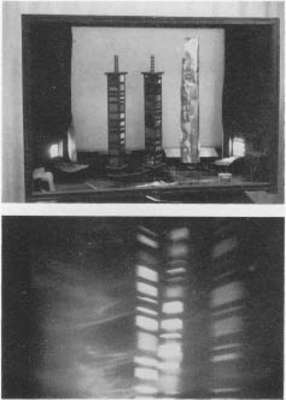
‘Entrechats, II’ No. 985/1966, audio-kinetic painting, Reflectodyne system, 60×80 cm, 1968.
Above: Interior view. Below: An image on the diffuser.
(On loan to Exploratorium, San Francisco, USA)
The artist on this kind of kinetic objects (Leonardo, Vol. 8, pp. 109-119):
»The following simple technique can be used to make the motion of a Reflectodyne system respond to sound (Fig. 8). The trees are rotated by a reversible electric motor whose current input is obtained from an electronic circuit consisting of a microphone, amplifier and a two-way relay. Below a given threshold of sound intensity, the relay in its first position sends a current to the motor, causing it to turn, say clockwise, and when the sound intensity exceeds the threshold, the relay flips to its second position and causes the motor to turn in the opposite direction. When rhythmic music or any sound of strong variation in intensity back and forth in phase with the sound input. I have also used such a circuit to control the motion of a kinetic sculpture.
A circuit with a thyratron in place of the relay can be inserted to cause the intensity of an incandescent lamp to vary in phase with the variation of the volume of sound input.
One of the objectives of the project for the General Electric Co. was to design an audio-kinetic device that would permit ready control of the picture by a viewer. Colors can be varied fairly readily by means of a button control. However, as far as I know, no one has succeeded in finding a way to change conveniently at will the basic character and style of a kinetic picture, that is, say, to change circular shapes into rectangular ones with a different succession of arrangements of them. This can be done with the Reflectodyne system by opening the case and replacing one set of trees by another but few viewers are likely to find this a satisfactory procedure. It may be that a viewer-controllable system cannot be constructed without going to prohibitive complexity and at too high a price for large scale home use.
Neither my audio-kinetic objects nor those that I have seen made by other artists strike me as being aesthetically satisfying. Viewers are at first awed when they realize that the motion or the light intensity of a kinetic picture is controlled by a sound input but this effect soon wears off. Since this article is concerned primarily with the visual aspects of electric light in art rather than with sound, I shall not probe further the problems of audio-kinetic art. I should add that I do not know electronics well enough to construct such circuits and I have turned to electronic engineers to construct the circuits for me.
My work for the General Electric Co. on audio-kinetic devices terminated not because the project was unpromising but because of the chance replacement of the company’s enthusiastic leader of it by an engineer who was interested in designing a low-price record player for children!
I have constructed a variation of the Reflectodyne system in which the image-making reflecting surfaces, consisting of blades of thin polished aluminum that can move like grass reeds, are put into motion by a current of air supplied by a fan installed in the case.
Artists have also produced kinetic pictures on opaque screens or on walls by reflecting light from shaped polished surfaces and by projecting light through large-scale rotating trees [1-4]. The latter installation provides a viewer both with an illuminated kinetic sculpture or construction and a kinetic electric light picture on the opaque surface.
I find that kinetic art systems that depend on the reflection of light from shaped polished surfaces for producing images on a translucent screen are rather limited as regards the range of subject matter and of styles that can be treated artistically. The light image reflected from a crinkled thin polished aluminum surface has an aesthetically satisfying quality but the design of the image is difficult to control. I have seen an interesting image from a piece of aluminum sheet vanish from the screen while I was trying to attach the sheet permanently to the case and have been unable to make it reappear. Reflectodyne-type kinetic pictures are handicapped further by the fact that they have to be viewed in a darkened room, unless lamps of large wattage are installed with their attendant heat problems. Light intensity from lamps is lost both through the reflection process and by transmission through the translucent screen.«


